appian ACD201 Exam Questions
Questions for the ACD201 were updated on : Nov 21 ,2025
Page 1 out of 7. Viewing questions 1-15 out of 99
Question 1
HOTSPOT
Match each action you want to perform to the appropriate log type.
Each log type will be used once or not at all. To change your responses, you may deselect your
response by clicking the blank space at the top of the selection list.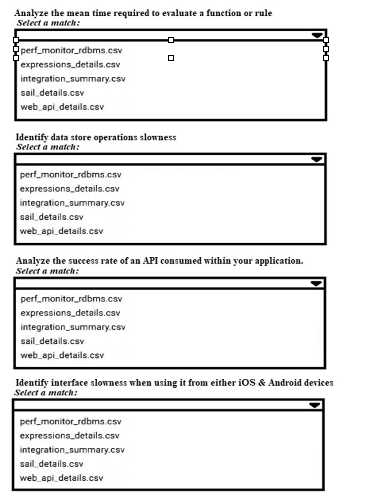
Answer:
None
Explanation:
Question 2
In reviewing the process model metrics of your application, you notice a process model with a
completion rate of only 10%.
What are two possible reasons for this low completion rate? (Choose two.)
- A. There are a significant number of instances that are experiencing process errors, which are not being handled by the production support team.
- B. The process contains at least one User Input Task with no exceptions or escalations, and users do not complete the task.
- C. There are a high number of smart service nodes configured in the process model.
- D. The days configured for archival or deletion is significantly higher than the other process models in your application.
Answer:
A, B
Explanation:
Process errors that remain unhandled will stall instances; those instances never reach an end event,
driving the completion rate down.
User-input tasks without deadlines, exceptions, or escalations can sit indefinitely when users do not
act, leaving instances in an active state and lowering the overall completion percentage.
Question 3
DRAG DROP
Your development team has selected Jenkins as a Continuous Integration (CI) system to integrate
testing of Appian into your overall testing strategy.
What should you do to set up automated testing of expression rules using Jenkins?
Note: To answer, move all steps from the Options list to the Answer List area and arrange them in the
correct order.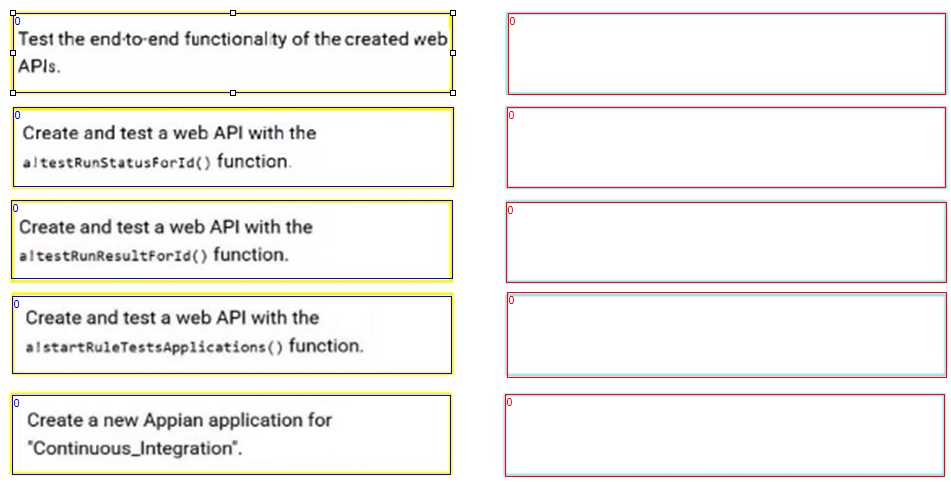
Answer:
None
Explanation: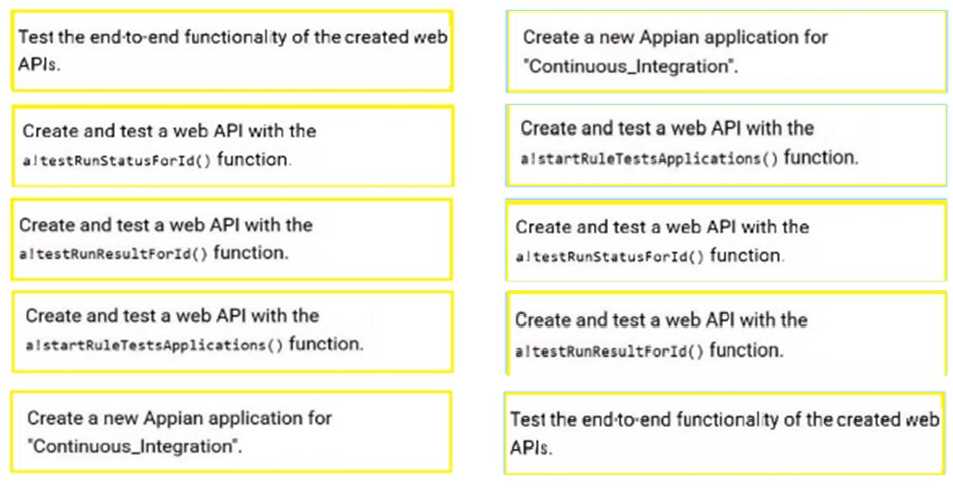
Question 4
After reviewing the latest Expression performance logs, you notice you have several expressions
contributing to slow interface or process performance.
Which two conditions will lead to a higher risk associated with slow-performing expressions?
(Choose two.)
- A. When the expression is used in a local variable.
- B. When the expression is used frequently or by many concurrent users.
- C. When the expression is evaluated on a mobile device.
- D. When the expression is a custom function plug-in.
Answer:
B, D
Explanation:
When the expression is used frequently or by many concurrent users.
A slow-running rule that executes a large number of times - or is triggered by many users at once -
multiplies its performance impact, raising the overall risk flagged in the expression-performance
logs.
When the expression is a custom function plug-in.
Custom Java plug-ins can introduce additional processing overhead (or poorly optimized code). If
such functions are slow, they typically appear near the top of performance logs and carry a higher
risk score.
Question 5
The synced record Task has a self-referential relationship defined in the column parentTaskId. There
is a many-to- one record relationship between the id and parentTaskId called parentTask.
For a given task ID, you need to return the task name and the parent task name.
What should you do?
- A. Use a!queryRecordType() With a filter on the task id, with fields specified to return recordType!Task.name and recordType!Task.parentTask.name.
- B. Create a sync-time custom record field on the Task record called parentName. Specify this field to return in the query field selection.
- C. Use a!queryRecordType() filtered on the task id once to return the task name and parent task ID. Query the record again to return the parent task name.
Answer:
A
Explanation:
A single a!queryRecordType() call filtered by the task’s id and selecting both recordType!Task.name
and recordType!Task.parentTask.name leverages the existing self-referential relationship, returning
the task name and its parent’s name in one efficient query without additional custom fields or extra
queries.
Question 6
You need to connect to an external system using OAuth 2.0: SAML Bearer Assertion Flow
authentication type, which requests access to an API on of a signed in user.
This standard has several steps involved with the SAML Bearer Assertion Flow.
Which two steps should you perform to connect to the external system? (Choose two.)
- A. Use an a!authorizationLink() on the relevant interface.
- B. Confiqure SAML for sinqle siqn-on (SSO).
- C. Generate a service account key in third-party systems.
- D. Register the connection in the third-party system
Answer:
B, D
Explanation:
Configure SAML for single sign-on (SSO).
The bearer-assertion flow relies on an existing SAML SSO configuration so Appian can issue a signed
SAML assertion on behalf of the signed-in user.
Register the connection in the third-party system.
You must register (or “trust”) Appian’s client/certificate with the external system so it will accept the
SAML assertion and issue an OAuth 2.0 access-token for the user.
Question 7
There are two record types, ABC and XYZ, with sync enabled. The XYZ record type is added as a
relationship into the ABC record type.
A user has Viewer permission to the ABC record type but does not have access to the XYZ record
type.
A site page is presented to the user where the data is sourced from the ABC record type and its
related record type the XYZ reference.
What information does the user see on the site page?
- A. Page is presented to the user and the data references to the XYZ record type appear as "null".
- B. Page is presented to the user with the XYZ record type data and fields references redacted.
- C. Page does not load and an error message is presented: "The record type [identifier=XYZ] does not exist, has been deleted, or you do not have sufficient privileges to access its data."
Answer:
C
Explanation:
Because the interface references fields on the XYZ record type, the user must have at least Viewer
permission on XYZ as well as on ABC. Since the user lacks access to XYZ, the query cannot be
executed and the page fails to load, displaying the error:
“The record type [identifier = XYZ] does not exist, has been deleted, or you do not have sufficient
privileges to access its data.”
Question 8
An insurance application has a dashboard in which all the cases with "Accident" case type and
"Health Insurance" insurance type are displayed to the user, using the following query:
You need to update the query entity to display all the cases that are "Accident" case type and "Health
Insurance" insurance type, or created in the last ten days.
What is the right configuration for the logical expression?
A)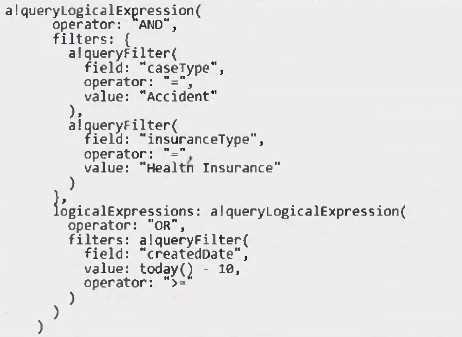
B)
C)
- A. Option A
- B. Option B
- C. Option C
Answer:
B
Explanation:
A filter for createdDate >= today() – 10 (records created in the last 10 days).
A nested AND logical expression that requires both caseType = "Accident" and insuranceType =
"Health Insurance".
Question 9
You have set up SAML for single sign-on (SSO) in your cloud environment.
Which three options could you enable in the Attribute Mapping section of the Admin Console to sync
with a user's profile in Appian? (Choose three.)
- A. "Create new users upon sign in."
- B. "Group Membership Synchronization."
- C. "Remember Me on web and mobile.'
- D. "Reactivate deactivated users upon sign in."
- E. "Update user attributes upon sign in."
Answer:
A, D, E
Explanation:
Create new users upon sign in - provisions new Appian users automatically when they first
authenticate through SAML.
Reactivate deactivated users upon sign in - automatically re-enables an Appian account if the user
returns after being deactivated.
Update user attributes upon sign in - refreshes profile details (e.g., name, email, custom attributes)
each time the user signs in.
Question 10
HOTSPOT
You're creating an application which has integrations with multiple systems using different protocols.
Match each process model component or node to the appropriate protocol.
Note: Each protocol will be used once. To change your responses, you may deselect your response by
clicking the blank space at the top of the selection list.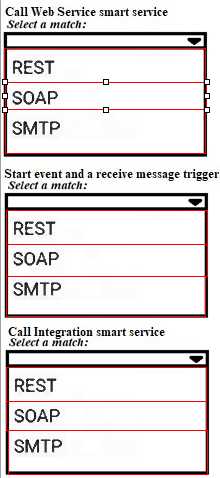
Answer:
None
Explanation:
Question 11
You're performing System Integration Testing on a client's application that integrates with an external
system.
In this instance, you're testing the application's interactions with external integrations to ensure that
data is being handled correctly between the two systems. However, this step has been done
manually and is time-consuming.
What should you do to make this process more efficient?
- A. Utilize the Postman API Platform to test the integrations with the external system and Appian's web APIs through a defined set of test cases.
- B. Utilize Appian-Locust to develop and execute performance tests on the systems integrations by scripting a scenario where multiple users are interacting with the external systems simultaneously.
- C. Utilize FitNesse for Appian to perform automated functional testing on the workflows that include integrated systems through a defined set of test cases.
Answer:
C
Explanation:
FitNesse for Appian is designed for automated functional testing of Appian workflows, including
those that call external integrations. By building repeatable FitNesse test scripts that drive the end-
to-end process, you can automatically verify that data is correctly sent to - and returned from - the
external system each time, greatly reducing the manual effort of system-integration testing.
Question 12
HOTSPOT
You’re developing a case management application. Currently, users can view a list of all cases
designed using a a!forEach() loop from a record query. Users can navigate to the case summary page
which shows the case details in a two (2) column layout. Users are also able to update the case
details.
During the last round of UAT testing, users reported that the tool was not intuitive to use.
Match each feedback comment to the suggested UI/UX improvements.
Note: Each UI/UX improvement will be used once, or not at all. To change your responses, you may
deselect your response by clicking the blank space at the top of the selection list.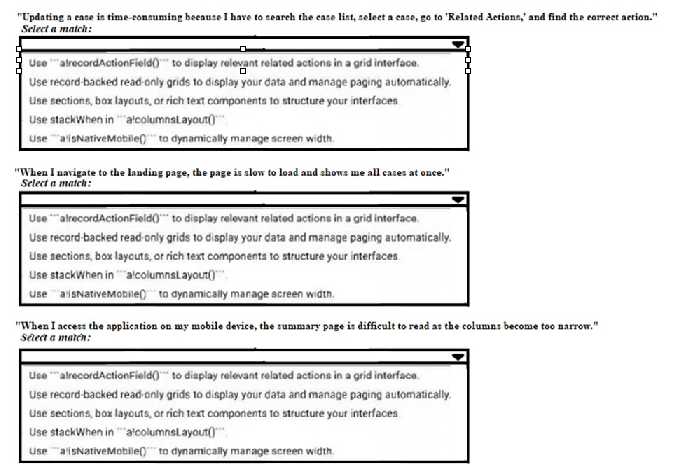
Answer:
None
Explanation:
Question 13
You need to relate two entities, Employee and Skill, in the data structure. You want to adhere to
Appian best practices.
Employees can have multiple skills, and a single skill can relate to multiple employees.
What type of relationship do these entities represent, and what is the minimum number of tables
required to implement the design?
- A. Many-to-many; 3 tables
- B. Many-to-many; 2 tables
- C. One-to-many; 2 tables
Answer:
A
Explanation:
The relationship between Employee and Skill is many-to-many - an employee can have multiple
skills, and each skill can belong to multiple employees.
To model this properly and according to Appian best practices, you need 3 tables:
Employee table
Skill table
EmployeeSkill (junction/association) table - contains foreign keys referencing both Employee and
Skill to manage the many-to-many relationship.
Question 14
You’re making a POST request to the Appian web API. You need to include complex data structures,
such as lists or objects, in the request body.
How should you design the API to accept those requests?
- A. Use query parameters to represent the complex data structures.
- B. Use XML format to represent the complex data structures in the request body.
- C. Convert the complex data structures to JSON and include them in the request body as a string.
Answer:
C
Explanation:
To include complex data structures like lists or objects in a POST request to an Appian Web API, you
should convert the data to JSON and include it in the request body as a string. Appian supports
application/json content type for parsing complex data structures in APIs.
Question 15
Your client wants their customers to be able to schedule appointments directly from their website
without going to an Appian user environment.
You need to build an embedded interface to be added to your client's web page. The style of the
embedded interface should be consistent with the host web page.
Which three custom styling options can be configured in the Themes section of embedded
interfaces? (Choose three.)
- A. Two or three column layout
- B. Page background color
- C. Asymmetrical layout
- D. Font Family
- E. Web font stylesheet URL
Answer:
B, D, E
Explanation:
Page background color - You can customize the background color to match the host webpage's
theme.
Font family - You can set the font family to ensure the embedded interface aligns with the client’s
branding.
Web font stylesheet URL - This allows the use of custom web fonts, further aligning the style with the
host site.